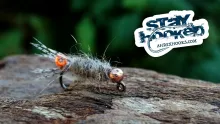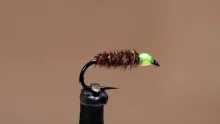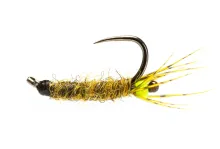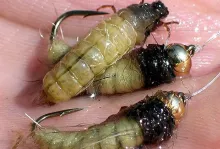This is a fly that was designed for a wooded canyon on one of the author’s favourite small rivers where the water has carved out a deep narrow channel through the limestone
This is a fly that was designed for a special place. It’s a wooded canyon on one of my favourite small rivers where the water has carved out a deep narrow channel through the limestone. Fishing is pretty much under the rod tip, there’s hardly space to cast anyway, so all you need outside the rod tip is the leader. This particular piece of water calls for a single reasonably heavy fly that can be flicked upstream and sinks quickly down to where the trout hang out.
The Canyon Caddis is tied on a heavy wire curved hook with an offset jig-off tungsten bead to provide the required weight and to flip the fly point up and minimise snagging on sunken logs. While it was initially tied for a small river it works just as well on bigger ones, either on its own or as a point fly with a dropper above. In extremis, with my local river falling after a flood, I have used it on a dropper with a heftier tungsten bug on the point to good effect.
I use DMC metallic embroidery thread for the tag and rib which adds subtle glints to the body as the fly catches the light while tumbling through the water, but you could use another metallic thread or copper wire, whatever you’ve got in fact.
1. Run on the thread behind the bead and build up turns to lock the bead in place.
2. Catch in a length of metallic thread and bind down around the bend.
3. Dub a tapered body leaving a space at the back for the tag.
4. Wind the metallic thread to form the tag and rib the body.
5. Strip the fibres from the base of a partridge hackle, snip out the tip to form a V and catch in with the fibres on either side of the hook.
6. Tie down the feather fibres and remove the hackle stem.
7. Add more dubbing up to the bead. Smear the thread with varnish and whip finish.
8. Remove the thread and brush out the dubbing from behind the bead.
- Log in to post comments




















